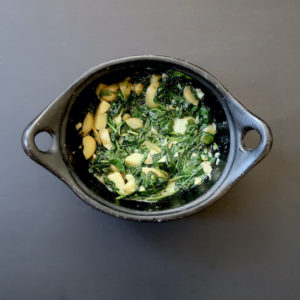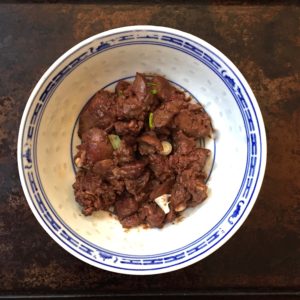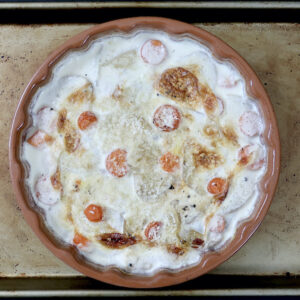Potato Knishes
So, hi.
Here we are on day whatever, depending on where you live. I haven’t kept count, myself.

I’ve been out exactly once in the past ten days. I tried shopping at the local market–a corner shop that stocks vegetables, wine, and some dry goods.
The shelves were literally bare. I took a photo, then stupidly deleted it. My ability to think straight has deteriorated significantly in recent days.

A lot of people are using this time to embark on cooking challenges; most take the form of sourdough. I am rather short on flour, so instead turned to potatoes. As Laurie Colwin writes, most people “store potatoes.”

Enter the knish.

Knishes are part of the enormous dumpling family, Ashkenazi branch (Eastern-European Jews). Knishes arose as a tasty way to use up leftovers, usually potatoes, cheese, or roast meats. Terrible liberties have been taken in the name of the knish; these are best ignored. The true knish is triangular (meaning mine are incorrectly shaped; more on this in the instructions) and no larger than a small woman’s hand. Their fillings should hark back to the food consumed in the freezing villages of Easten Europe. Meaning: do not fill your pastry with tofu or plant-based fake meat products and call it a knish. It may be something, and some people may even eat it. But it’s not a knish.

Excuse me while I go give my sheltering in place husband his lunch. He’s home. I love the guy. But he’s disabled, and his caregiver can’t come here because, well, shelter in place. My workload has soared.

Hi. I’m back. He had leftover Chinese food, home-made. In case you were curious.

I could have edited the cell phone cord out, but I feel it truly adds to the photo. You know, art and all that stuff.
Returning to our knishes.

Definitely a work in progress.
Ashkenazi food is often derided as heavy, both literally and metaphorically. Granted, a diet based on cabbage, sour cream, chicken fat, and the occasional festive bird isn’t exactly the stuff of Cardiology Today. But my ancestors lacked access to our Sephardi cousins’ sunny skies and vegetable bounty. We were forced to make do with crummy weather and maurading armies. And so we did. Nobody will ever call a knish ethereal, but they are indeed delicious, and at times like these, what more can you ask for?

Potato Knishes
Adapted slightly from Claudia Roden’s Book Of Jewish Food
Yield: 18-24
Prep Time: about 1 hour hands-on work, an hour for dough to rest, and about 25 minutes baking time
for the knish dough:
2 eggs
1/2 teaspoon Kosher salt
1 teaspoon baking powder
2 tablespoons vegetable oil (I used canola)
approximately 1 1/2 cups/250 g all-purpose flour (you may not use it all)
One egg, cracked into a small bowl and beaten for a wash
for the potato filling: please see notes
1-2 medium onions, finely chopped (see notes)
1 pound/500 g potatoes, ideally Russet
salt and pepper
Make the knish dough:
Crack the eggs in a large bowl. Add salt, baking powder, and oil. Stir with a fork to blend. Add flour gradually, using only as much as you need to form a soft dough. Roden advises using a fork, then your hand to knead the dough. I prefer dumping it on the counter and kneading. Whichever method you use, you’re looking for a dough that is neither sticky nor dry. Don’t add more flour than necessary. I only needed about 1 1/4 cups flour, I did need to add little more oil to make the dough cohere.
Wrap dough in plastic wrap or cover with a clean bowl in a warm place. Allow to rest for at least an hour. Mine sat for just under two hours.
Make the filling:
Slice onions and cook them in the poultry fat, taking care not to burn the onions. If you are a Jew, try not to cry as the smell fills your kitchen.
For Claudia Roden’s potato filling:
Boil the unpeeled potatoes until soft. Peel when cool enough to handle. Mash. Add onions, all the cooking fat, salt and pepper.
For my potatoes, add a heaping 2 tablespoons sour cream to above and mix in.
Set aside while you roll the dough:
The dough should be rolled as thinly as possible. Work from the center outward. Be patient. I flipped the dough a few times, which helped. I also used my hands to gently stretch and flatten it.
When the dough is to your liking, fill and form the knishes. You can make traditional triangular shapes, or you can make the slightly weird shapes I made.
To cut triangles, according to Mrs. Mildred Bellin’s The Jewish Cook Book, published in 1958:
Roll the dough until it is 1/18th of an inch thick. Then cut it into squares. Fill each square with a scant tablespoon of filling, then fold corner to corner to make a triangle. Press edges together firmly.
Set each knish on lightly oiled baking sheet.
To make dumpling shapes, cut the dough into rounds. Fill the center of each round with a scant tablespoon of the filling. Fold over, pulling up edges gently. Crimp together and pinch closed. This is easier than it sounds.
Place each knish on an oiled baking sheet. Paint each lightly with egg wash.
Bake 20-25 minutes, until golden and aromatic. Try not to eat them all at once. If you manage to have any left over, knishes may be reheated in a toaster or regular oven at low heat. A microwave will give you rubber.
Freeze unbaked knishes by placing them in the freezer on a baking tray for 30 minutes. Then either decant into a freezer bag or other freezer container up to three months. Bake from frozen.
Notes:
For the potato filling: Roden is following Jewish dietary law, so her potato filling is very simple. I found it a bit bland, so added sour cream. Use the recipe filling or your preferred mashed potato recipe, bearing in mind this is acting as a filling, so it cannot be runny. No Joel Robuchon potatoes here.
As my spouse dislikes onions, I used one stalk of new garlic.
I sauteed the garlic in leftover goose far from Christmas. Chicken or duck fat also work. You can use butter or oil, but the knish won’t be as good.
Render your own chicken fat by pulling off skin or clumps of fat from a whole bird, slicing it, and melting it in a frying pan over low heat with a little water. Low heat and time are key here. Cracklings, called gribenes in Yiddish, are reason to live. Eat them all yourself. You can also freeze or refrigerate them and add them to anything. Except dessert.

As I write, it is just coming to press that Chef Floyd Cardoz has died of complications from Coronavirus. Chef Cardoz was only 59 years old. Chef Cardoz increased the visibility of Indian food in New York City–and across the country–with restaurant Tabla, numerous cookbooks, and a lively television personality. He is survived by his wife, children, and mourning fans. RIP, Chef.




